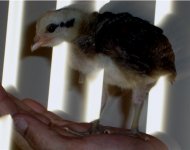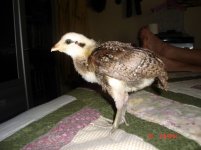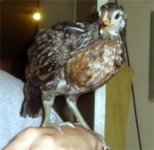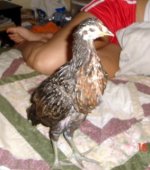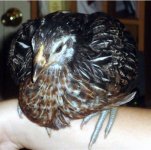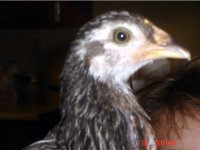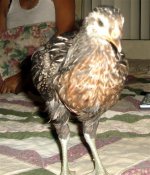-
Welcome to BirdForum, the internet's largest birding community with thousands of members from all over the world. The forums are dedicated to wild birds, birding, binoculars and equipment and all that goes with it.
Please register for an account to take part in the discussions in the forum, post your pictures in the gallery and more.
You are using an out of date browser. It may not display this or other websites correctly.
You should upgrade or use an alternative browser.
You should upgrade or use an alternative browser.
i need help plz (1 Viewer)
- Thread starter HAVIXX81
- Start date
More options
Who Replied?I'm not really sure what it is. I have a guess, but either way, I'd probably go put that bird back where you found it as soon as possible. It looks like it was getting close to fledging and probably didn't need rescuing, just some more time to get its wings working.
Edit: To me it looks like it may be some sort of bird of prey, which would be even more of a reason to return it since getting caught with a baby bird of prey will get you a hefty fine or a short stint in jail depending on how the judge is feeling at the time.
Edit: To me it looks like it may be some sort of bird of prey, which would be even more of a reason to return it since getting caught with a baby bird of prey will get you a hefty fine or a short stint in jail depending on how the judge is feeling at the time.
Last edited:
reguarding baby bird found
I was checking in a bird book pg,242 of the birds of North America Book, and the only thing I can remotely find close to this is what is called a logger head shrike. These are the only type of bird that looks like that that is in the united states and remotely close to the pictures you posted . The Northern Shrike is located in Canada and the surrounding areas. Shrikes are actually birds that prey upon insects, small birds and rodents. If I were you, I would put this little bird back if it's not too late. As with all baby birds, The majority of the mother birds will abandon their young if they sense or smell human scent on them. So you should handle it as little as possible and get it back. If not I would contact a wild life center such as a nature center or a zoo to help it rehabilitate til it gets big enough to learn to fly and be reintroduced in the world.
I have done my share of bird rescue and I've lost alot of them due to stress of being away from the mother but I did successfully raise a baby robin til it was old enough to fly and it was the most rewarding thing I could have done, but it's better if it's own spieces or a professional can take care of it.
HAVIXX81 said:Hi everyone! well a few weeks ago i happen to rescue a baby bird and i dont any idea what kind of bird it is i was wondering if anyone can help me identify it. or if u can tell me anything about it...
I was checking in a bird book pg,242 of the birds of North America Book, and the only thing I can remotely find close to this is what is called a logger head shrike. These are the only type of bird that looks like that that is in the united states and remotely close to the pictures you posted . The Northern Shrike is located in Canada and the surrounding areas. Shrikes are actually birds that prey upon insects, small birds and rodents. If I were you, I would put this little bird back if it's not too late. As with all baby birds, The majority of the mother birds will abandon their young if they sense or smell human scent on them. So you should handle it as little as possible and get it back. If not I would contact a wild life center such as a nature center or a zoo to help it rehabilitate til it gets big enough to learn to fly and be reintroduced in the world.
I have done my share of bird rescue and I've lost alot of them due to stress of being away from the mother but I did successfully raise a baby robin til it was old enough to fly and it was the most rewarding thing I could have done, but it's better if it's own spieces or a professional can take care of it.
Katy Penland
Well-known member
If this bird was rescued "a few weeks ago," as the poster indicated, what happened to it? Was it returned safely to the wild? Was it taken to a rehabber or vet? Did it die?
Havixx81, for future reference, please read the info page at the below URL before removing any more chicks from the wild:
http://www.birdforum.net/showthread.php?t=36564
I also cannot stress enough that in the US, it is illegal to handle, transport, harass, keep, or otherwise capture any wild birds protected by federal law unless you have the proper permits and licenses to do so. And in the US, only a handful birds are not federally protected (e.g., House Sparrow, Rock Dove, European Starling, and other introduced species).
Havixx81, for future reference, please read the info page at the below URL before removing any more chicks from the wild:
http://www.birdforum.net/showthread.php?t=36564
Sorry, EKB, but the "human scent" issue is a myth. Adult birds abandon chicks and nests due to disturbance either by humans or predators, not because a human has handled the nestlings. This is exactly why people are urged to get baby birds back into nests, if possible, if the birds are too young to be fledges, are found on the ground and if the nest is reachable. Please see the info page I've referenced above.ekb028 said:As with all baby birds, The majority of the mother birds will abandon their young if they sense or smell human scent on them. So you should handle it as little as possible and get it back. If not I would contact a wild life center such as a nature center or a zoo to help it rehabilitate til it gets big enough to learn to fly and be reintroduced in the world.
I have done my share of bird rescue and I've lost alot of them due to stress of being away from the mother but I did successfully raise a baby robin til it was old enough to fly and it was the most rewarding thing I could have done, but it's better if it's own spieces or a professional can take care of it.
I also cannot stress enough that in the US, it is illegal to handle, transport, harass, keep, or otherwise capture any wild birds protected by federal law unless you have the proper permits and licenses to do so. And in the US, only a handful birds are not federally protected (e.g., House Sparrow, Rock Dove, European Starling, and other introduced species).
ekb028 said:As with all baby birds, The majority of the mother birds will abandon their young if they sense or smell human scent on them.
I heard this was a fallacy because most birds have a very limited sense of smell. Anyone else have any ideas about that?
This bird is way to big to be a shrike. The legs are too long and thick, the beak is wrong, and the dorsal feathers are brown when they should be gray.
Edit: Ha, I guess I should read the rest of the posts before I put things down. Thanks Katy.
Last edited:
i tried to put it back
well when i found the bird a cat was eating another baby and i looked around and i cant find where it came from. The lil bird that i found its wing was bloody and it wouldnt move, but now its been a month and its pretty big now
affe22 said:I'm not really sure what it is. I have a guess, but either way, I'd probably go put that bird back where you found it as soon as possible. It looks like it was getting close to fledging and probably didn't need rescuing, just some more time to get its wings working.
Edit: To me it looks like it may be some sort of bird of prey, which would be even more of a reason to return it since getting caught with a baby bird of prey will get you a hefty fine or a short stint in jail depending on how the judge is feeling at the time.
well when i found the bird a cat was eating another baby and i looked around and i cant find where it came from. The lil bird that i found its wing was bloody and it wouldnt move, but now its been a month and its pretty big now
Katy Penland
Well-known member
I'm going to go out on a very long limb here. If this is a Bobwhite that was "found" anywhere in California, I'll eat a chicken. Oh, wait. Maybe this is a chicken.
Joern Lehmhus
Well-known member
Looks very much like a chicken or pheasant!
Already from the very first photo in this thread it is clear that this is not a raptor (or a songbird like Loggerhead shrike)!!! While it is still downy , it has already well debveloped flight feathers on that photo... that is something typical for pheasants , chickens , quails etc!
EDIT: it seems to develop a comb on the last pics? the chicken option becomes more likely!
Already from the very first photo in this thread it is clear that this is not a raptor (or a songbird like Loggerhead shrike)!!! While it is still downy , it has already well debveloped flight feathers on that photo... that is something typical for pheasants , chickens , quails etc!
EDIT: it seems to develop a comb on the last pics? the chicken option becomes more likely!
Last edited:
iainhawk
Well-known member
Smell on birds
affe22 said:I heard this was a fallacy because most birds have a very limited sense of smell. Anyone else have any ideas about that?
A lot of scientists test evolutionary questions on bird reproduction by moving birds between nests of study populations (cross fostering), and this involves handling the birds or eggs. As long as the scientists are doing it properly there is no increase in mortality or other problems associated with this sort of thing.
There is no indication of birds being able to detct a human scent at all. Or if they can are not bothered by it. in my experience the parents continue to feed within minutes of such cross-fostering, due to the stimulation of the begging calls and other chick-based methods of stimulating parent to feed.
I think that it is a good fallacy to maintain- as it makes people think of whether or not they should handle young birds or not- in most cases the bird is better off left to its own devices.
So, I was completely wrong on the osprey idea. My bad. I'm going to say it is definitely an escaped chicken and I suppose those are alright to possess. I just wouldn't go around picking up many other birds. If a cat was eating them, well, that's the way the world works, even if cats shouldn't be outside eating native birds.
birdpotter
Well-known member
I was thinking chicken all along as I was reading the posts.
Too goofy looking for anything else. Why, look at those thighs...
Well, then, you either have a very nice pet, or a tasty meal!!
Best
Too goofy looking for anything else. Why, look at those thighs...
Well, then, you either have a very nice pet, or a tasty meal!!
Best
Birdie
Grey Jungle Fowl? From the location and such, it's probably a chicken. Note the three forward pointing toes of the chick pic however. Raptors pretty much never have that configuration.
The Red Jungle Fowl, or primal chicken as I call it, is a very handsome bird indeed. It would definitely be of interest if it weren't for the fact that their are probably more than 20 billion chickens in the world.
Grey Jungle Fowl? From the location and such, it's probably a chicken. Note the three forward pointing toes of the chick pic however. Raptors pretty much never have that configuration.
The Red Jungle Fowl, or primal chicken as I call it, is a very handsome bird indeed. It would definitely be of interest if it weren't for the fact that their are probably more than 20 billion chickens in the world.
Users who are viewing this thread
Total: 2 (members: 0, guests: 2)




